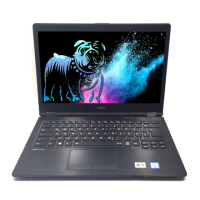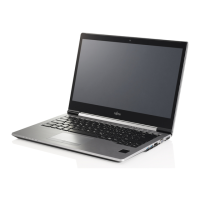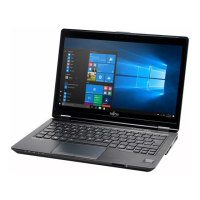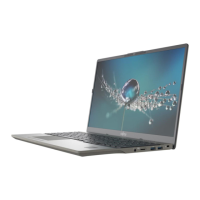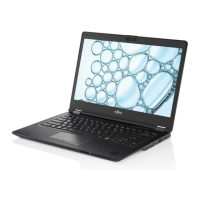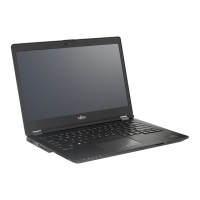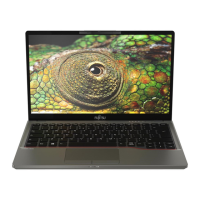Do you have a question about the Fujitsu Lifebook U749 and is the answer not in the manual?
Provides information on Windows drivers and software updates.
Explains symbols, text formatting, and keys used throughout the manual.
Details front, left, right, and bottom ports for LIFEBOOK U729.
Details front, left, right, and bottom ports for LIFEBOOK U749.
Details front, left, right, and bottom ports for LIFEBOOK U759.
Essential safety information and warnings for notebook operation.
Specific safety guidelines for wireless features like LAN and Bluetooth.
Tips for energy saving, traveling safety, and notebook cleaning.
Steps for unpacking, checking, selecting a location, and connecting the mains adapter.
Procedure for initial power-on, software installation, and configuration.
Explanation of the notebook's various status lights and their meanings.
Guide to keyboard features, virtual keypad, function keys, and touchpad.
Information on charging, caring for, and managing the notebook's battery and power.
Overview of wireless, LAN, and LTE connection setup and usage.
Configuring fingerprint/palm vein sensors and using the security lock.
Managing BIOS passwords and OS boot protection.
Securing the hard disk and configuring the Trusted Platform Module.
Inserting and using the SmartCard for authentication and encryption.
Instructions for connecting various types of external displays like VGA, DVI, HDMI.
Guide to connecting USB devices, including Thunderbolt and charging ports.
Information on connecting audio devices like headsets and speakers.
General precautions for handling components, ESD sensitivity, and preparation.
Procedures for installing and removing memory modules and M.2 modules.
Steps for removing and reattaching device covers for component access.
Steps to enter, navigate, and change settings within the BIOS Utility.
Various methods for saving or discarding changes and exiting BIOS.
Procedures for fault diagnosis, contacting support, and system recovery.
Troubleshooting specific problems like date/time, keyboard, display, and connectivity.
Explanations and solutions for BIOS error messages.
Details on ambient conditions, dimensions, weight, and memory.
Technical details on rechargeable batteries and power adapters.
Guidelines for proper disposal, recycling, and certification marks.
Provides information on Windows drivers and software updates.
Explains symbols, text formatting, and keys used throughout the manual.
Details front, left, right, and bottom ports for LIFEBOOK U729.
Details front, left, right, and bottom ports for LIFEBOOK U749.
Details front, left, right, and bottom ports for LIFEBOOK U759.
Essential safety information and warnings for notebook operation.
Specific safety guidelines for wireless features like LAN and Bluetooth.
Tips for energy saving, traveling safety, and notebook cleaning.
Steps for unpacking, checking, selecting a location, and connecting the mains adapter.
Procedure for initial power-on, software installation, and configuration.
Explanation of the notebook's various status lights and their meanings.
Guide to keyboard features, virtual keypad, function keys, and touchpad.
Information on charging, caring for, and managing the notebook's battery and power.
Overview of wireless, LAN, and LTE connection setup and usage.
Configuring fingerprint/palm vein sensors and using the security lock.
Managing BIOS passwords and OS boot protection.
Securing the hard disk and configuring the Trusted Platform Module.
Inserting and using the SmartCard for authentication and encryption.
Instructions for connecting various types of external displays like VGA, DVI, HDMI.
Guide to connecting USB devices, including Thunderbolt and charging ports.
Information on connecting audio devices like headsets and speakers.
General precautions for handling components, ESD sensitivity, and preparation.
Procedures for installing and removing memory modules and M.2 modules.
Steps for removing and reattaching device covers for component access.
Steps to enter, navigate, and change settings within the BIOS Utility.
Various methods for saving or discarding changes and exiting BIOS.
Procedures for fault diagnosis, contacting support, and system recovery.
Troubleshooting specific problems like date/time, keyboard, display, and connectivity.
Explanations and solutions for BIOS error messages.
Details on ambient conditions, dimensions, weight, and memory.
Technical details on rechargeable batteries and power adapters.
Guidelines for proper disposal, recycling, and certification marks.
| Graphics | Intel HD Graphics 620 |
|---|---|
| Operating System | Windows 10 Pro |
| Wireless | Wi-Fi 802.11ac, Bluetooth 4.1 |
| Processor | Intel Core i5-7200U |
| Storage | 256 GB SSD |
| Display | 14 inch FHD (1920 x 1080) |
| Battery Life | Up to 12 hours |
| Ports | USB-C, USB 3.0, HDMI, Ethernet |
